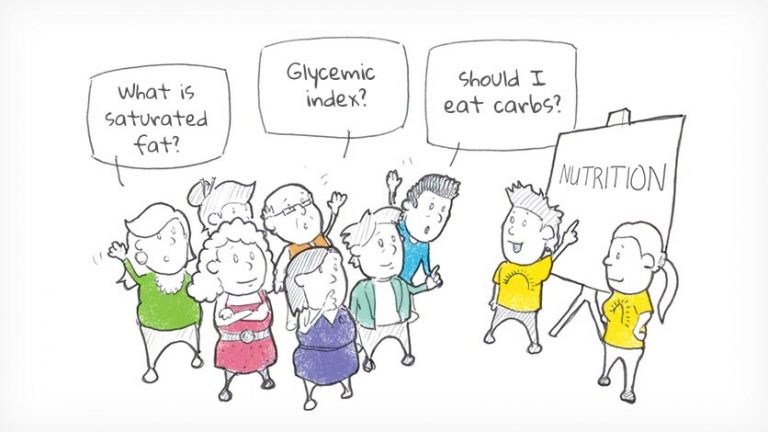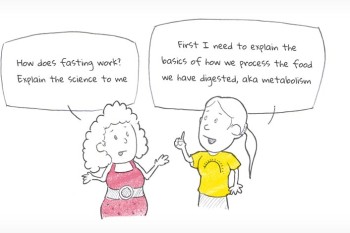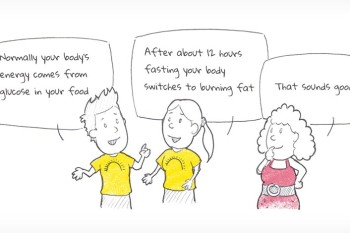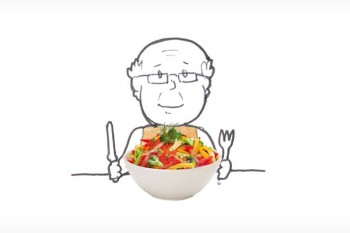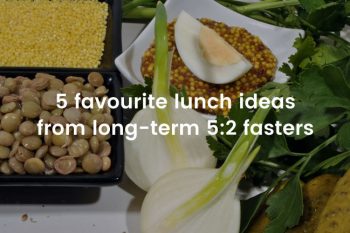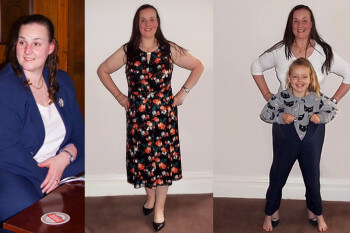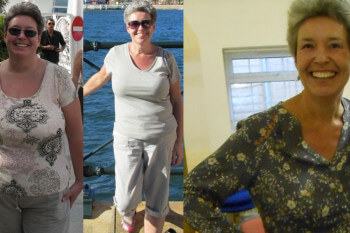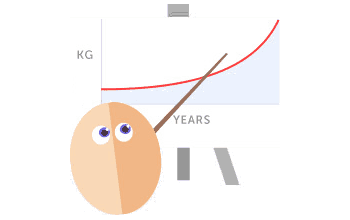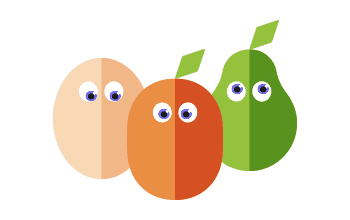There is so much conflicting advice about what constitutes a healthy diet these days, that we are left with more questions than answers: are carbohydrates good or bad? Is saturated fat healthy? How much protein should we eat? Is five portions of vegetables a day the right number? Here we give you the tools to find your way through this minefield of information.
You have probably heard of the three so-called macronutrients: carbohydrates, fats and proteins. Our foods are composed of different mixtures of the three. Let’s have a quick look at them.
Carbohydrates
Carbohydrates (carbs) are used in the body to make glucose, one of the body’s energy-giving fuels. Some of the glucose is used immediately; most of the rest is stored in the body as fat (some is stored in our liver and muscles). Foods high in carbohydrates are also high in calories and it is easy to over-eat these foods and gain weight. There are two main types of carbohydrates:
- Simple carbohydrates or sugars, such as enriched flour, found in refined breads, pastas, and sugary foods, provide calories but few nutrients.
- Complex carbohydrates or starches, such as whole-grain breads, starchy vegetables and beans, contain valuable vitamins and minerals as well as being high in fibre.
Complex carbs release their glucose more slowly than simple carbohydrates and so are preferable. This is because high glucose levels in the blood are dangerous: slow release of glucose into the bloodstream is safer. Foods that release glucose quickly are said to have a high “glycaemic index” (GI). High carbohydrate foods with a high GI include:
- Sugar and sugar-containing foods, such as sweets, candies, cookies, biscuits, cakes and pastries, jams and even some savoury foods that have been sweetened.
- Honey, breads and anything containing white flour, such as white pasta, refined breakfast cereals such as cornflakes, cocoa pops and the like
- White rice
- Some fruits such as pineapple, watermelon, dried fruits (dates, raisins etc)
- Parsnips
- Potatoes
High carbohydrate foods with a low GI include
- Whole grain cereals such as porridge oats, oat bran, and other grains, brown rice, brown pasta, wholemeal bread
- Bananas, carrots and other root vegetables such as beetroot, sweet potato and pumpkin
- Legumes and pulses.
To find the GI of any particular food, try this tool. We should also mention fructose when talking about the carbohydrates in our diet. Fructose is a kind of sugar found in plants. It is similar to glucose and, in fact, ordinary table sugar is composed of a mixture of glucose and fructose. Foods high in fructose, (apart from foods containing normal table sugar) include high-fructose corn syrup, agave nectar, honey, molasses, maple syrup and fruit juices. Fructose cannot be used immediately for energy by the body and, instead, is turned into fat and stored. This process occurs in the liver and much of the fat stays there in the liver. A fatty liver is a bad thing and this is one reason why high fructose consumption has been considered to be particularly dangerous for our health.1 It has been linked with worsening insulin resistance, obesity, LDL cholesterol and triglycerides. But whether it is more dangerous in this regard than high glucose consumption is not clear.2 In either case, foods high in sugar are not healthy. Curiously, we don’t actually need any carbohydrate in our diets. Our bodies can manage just fine without them as long as we have enough protein in our diet – our bodies can easily use fat as the energy source instead. Learn more about how the body processes and stores carbohydrates
Fats
Fats are a great source of energy for the body and there are some fats that are essential. This means that we must have some fat in our diet. How much fat we should eat has been the matter of great debate in recent years. It seems that the right amount of fat depends on how much carbohydrate we eat. If we eat a high carbohydrate diet, then a relatively low fat content seems to be healthiest. However, if we keep carbohydrates down then we can safely eat more fat. There are many health benefits when our bodies burn fat for fuel (instead of carbs) – whether the fat comes from our fat stores or from the fat we eat. Learn more about fasting and burning fat. There are different kinds of fats in our foods:
- Saturated fats: these fats are solid at room temperature and tend to come from animal sources such as dairy products and fat on meats (a notable exception being coconut oil). There is still much debate among scientists as to whether saturated fat is bad for our health, but the evidence that saturated fat is not harmful is increasing. An new analysis of studies on saturated fat intake, involving over 300,000 people found no link between saturated fat intake and heart disease.3 It seems likely that it depends a lot on what else we are eating (as mentioned above) such that if we don’t over-eat carbohydrates then saturated fat is not harmful and may even be beneficial.4
- Unsaturated fat: these fats are liquid at room temperature and tend to come from vegetable sources. There are some different types of unsaturated fats:
- Poly-unsaturated fats are either ‘omega-3’ or ‘omega-6’. We need both omega-3 and omega-6 fats as our bodies cannot make them from other ingredients and they are essential to our health. However, we need the correct balance of omega-3 to omega-6 fats and some people think that if we eat too much omega-6 fats it can cause obesity, inflammation and increase the risk of heart disease.5 Examples of foods high in omega-3 are rapeseed oil, flaxseed oil, nuts and seeds and oily fish such as mackerel, trout, herring, and salmon. Examples of foods high in omega-6 are safflower oil, corn oil and soybean oil. Most people eat enough omega-6 fats but tend to have too little omega-3 fat.
- Mono-unsaturated fats are thought to be good for our health and are found in nuts and seeds and their oils, olives and olive oil, avocados and canola oil.
- Trans fats are unsaturated fats that have been made more solid by a process called hydrogenation. In this process, hydrogen is added to liquid oil turning it into solid fat. Food manufacturers use artificial trans fat in food products because it is inexpensive and it increases the food’s shelf life, stability, and texture. You might have heard of trans-fats in connection with an increased risk of heart disease.6 Consuming trans-fat increases low-density lipoprotein (LDL, or “bad”) cholesterol. Sadly, trans fats are still widely used in pre-prepared foods, which is one reason why many nutritionists call for more people to eat home prepared foods as this alone can lower the amount of trans fats being eaten.
Fats are, of course, very high in calories and we should try not to over-eat fatty foods. Luckily, foods containing fats are more filling than those containing carbohydrates. Foods that are high in both carbohydrates and fat are normally a problem for us. They are very easy to over-eat, and can cause health and weight problems. Sadly, these kinds of foods are so very tasty: crisps, chips and fries, cakes, cookies, biscuits, pastries and other baked goods, crusty french bread with a thick layer of butter!
Protein
Protein makes up a big part of our bodies: the muscles of course, but also skin, nerve, eyes, indeed every cell and organ of the body contains protein. All the cells in the body are constantly being broken down and replaced with fresh new ones. The protein in the foods we eat is digested into amino acids that we need to make new cells and repair existing ones. Good sources of protein are:
- meats, poultry, and fish
- legumes (dry beans and peas)
- tofu
- eggs
- nuts and seeds
- milk and milk products
Once we reach adulthood, we don’t need to eat much protein to supply our body’s needs, and too much protein may increase the risk of developing cancer.7 In fact we cannot store protein for later use and so any protein that is not needed by the body for repair is turned into glucose and used for energy.
Micronutrients
As well as the big three (carbohydrates, fats and proteins) there are a host of other nutrients that the body needs in small amounts. These so-called micronutrients include vitamins and minerals and certain other compounds. Some important vitamins and minerals which can sometimes be hard to get enough of in our food are:
- Vitamin D (essential for absorption of calcium, iron, magnesium, phosphate and zinc, for healthy bones, heart, kidney and immune system, good sleep to name but a few)8,9
- Vitamin B6 (used to build proteins out of amino acids; essential for good heart and nerve health, helps control blood pressure and is required to make red blood cells)10
- Vitamin B12 (involved in the functioning of every cell in the human body, particularly important for the brain and nerves)11
- Magnesium (involved in the functioning of every cell in the human body, particularly important for blood pressure, heart health, good sleep, muscle and nerve function, calcium absorption, bone health, kidney health)12
- Calcium (needed for bone growth and strength, blood clotting, muscle contraction, and more)13
- Chromium (helps control blood sugar levels and is involved in fat metabolism)14
- Folate (important for nerve, brain and heart health and for cell growth)15
- Iron (needed to make red blood cells – a deficiency results in anaemia)16
- Iodine (needed to make thyroid hormone)17
- Selenium (protects cells from damage and helps manage thyroid hormone)18
- Potassium (important in reguating blood pressure)19
- Phytonutrients (chemicals produced in small amounts by plants, that have been found to benefit our health in a variety of ways)20
There is a big industry surrounding the marketing and selling of micronutrients to people who are worried they may be deficient in certain vitamins and minerals and yet there is little scientific evidence that many people are actually deficient. Further there are indications that taking supplements might not be simply a waste of money but may also carry risks to our health.21 It is always best to try to eat foods rich in micronutrients rather than take supplements. Foods that are particularly high in these hard-to-find micronutrients include:
- Green leafy vegetables (potassium, magnesium, iron, chromium, folate)
- Nuts and seeds (selenium, magnesium, omega-3 fats)
- Dairy products (calcium, iodine)
- Beans and legumes (folate, calcium, iron, B vitamins, potassium)
- Brightly coloured vegetables like bell peppers, tomatoes, carrots, sweet potatoes (carotenoids, flavenols and polyphenols)
- Berries (folate, vitamin C and potassium)
- Mushrooms (vitamin D)
- Seafood, especially oily fish (vitamin D, iron, iodine, omega-3 fats)
- Eggs (vitamin D, iron, potassium).
Food groups
Because most foods are a mixture of carbs, fats and protein, foods with similar compositions can be collected together to make the main food groups:
- Starches and grains – bread, pasta, rice, flour, corn and potatoes – these are mostly carbohydrate and are low in fat and protein.
- Dairy and milk-alternative products – milk, soft and hard cheeses, fromage frais, cream, yoghurts – this group is fairly high in carbohydrate but is also high protein. The amount of fat varies a lot – cheese and cream are high in fat, low fat yoghurts or skimmed milk are low.
- Meat, poultry and fish – beef, lamb, pork, ham, bacon, sausages, chicken, turkey, duck, pate, fish and also meat substitutes like soy protein or quark – high in protein, no carbs but again, fat content varies considerably.
- Fish are worth mentioning separately because the oily fish (salmon, trout, tuna, mackerel, herring) are particularly high in that essential fat, omega-3.
- Fats and oils – butter, margarine, cooking oils, olive oil, crisco, lard, suet – are virtually all fat.
- Vegetables – all green vegetables and root vegetables apart from potatoes and sweet potatoes – contain lots of micronutrients, varying amounts of carbohydrates, no fat (apart from avocados) and small amounts of protein.
- Fruit – apples, pears, plums, peaches, grapes, melon, strawberries – is often put in the same group as vegetables but are often much higher in carbs than vegetables.
- Nuts and seeds – almonds, walnuts, pecans, peanuts, cashews, macadamias, sunflower seeds, flax seeds, chia seeds – are high in protein and fat (especially omega-3) and very low in carbohydrates.
- Sugars, syrups, sweets and candies, cookies and biscuits, cakes and pastries – very high in carbohydrates and (apart from sugars, syrups, sweets and candies) fat too, but no other nutritional value!
Dietary fibre: a nutrient or just filler?
Dietary fibre is term given to carbohydrates in our diet that resist digestion by our bodies. Dietary fibre comes from plants and can be divided into different types.
- Some fibre dissolves easily in water – this is called soluble fibre. Soluble fibre is fermented in the lower gut by beneficial bacteria and encourages their growth. The roles of these beneficial bacteria in human health is an area of intense research but early work suggests that they may have many positive influences.22 Beans, greens and oats are particularly high in soluble fibre.
- Some fibre does not dissolve in water – this is called insoluble fibre. Most plants contain a mixture of soluble and insoluble fibre. There are two kinds of insoluble fibre:
- Some insoluble fibre is able to be fermented in the large intestine – this is called resistant starch. Resistant starch acts like soluble fibre in the gut as it is fermented by the beneficial bacteria mentioned above and encourages their growth. Resistant starch has been suggested to be able to help blood glucose and weight control.22 Resistant starch is found in foods such as seeds, unprocessed whole grains, unripe bananas, legumes and potatoes.
- The rest is not digested at all and acts to bulk out the stools and helps prevent constipation.22
This division of dietary fibre into different types is further complicated by the fact that cooking and processing foods changes the balance of the different types of fibre.22 Therefore, it is hard to know how much of the fibre we eat is giving us nutrients (also called functional fibre) and how much is filler (though this is useful too). For this reason, the values for recommended amounts of fibre quoted by health professionals and governments are not particularly helpful as they do not consider the different types of fibre.
A balanced diet
Now you know what types of foods are high in carbohydrates, fats and proteins and which contain many essential micronutrients, how do you know if your diet is balanced and healthy? At FastDay we don’t want you to be denying yourself foods that you love but we do want you to succeed on your journey to better health, so we won’t give you any fixed rules about what you should or shouldn’t eat. Instead here are some guidelines that you might like to bear in mind.
- A calorie is not just a calorie: the balance of where you calories come from is just as important as the total number of calories you eat. As mentioned above, the balance of carbohydrate to fat can influence our health, so eating mindfully is about trying to keep a healthy balance without feeling deprived or that there is no room for variety.
- Carbohydrates: Too high a carbohydrate intake is not good for health. As mentioned above, we don’t actually need to eat any carbohydrates for our bodies to function properly. But many foods that contain carbohydrates also contain other important nutrients. A good rule for a balanced amount of carbohydrate on a non-fast day is to aim for 100–150g per day. This is lower than you might have been used to but not as low as a typical low carbohydrate diet.23–25 If you use an app to track your calories you can also use it to see how much carbohydrate you are eating, or you can use the list at the bottom of the page to estimate how much carbohydrate you are eating. Some people find they need to reduce carbohydrates lower than this, especially if they have diabetes or pre-diabetes or are struggling to lose weight. On a fast day it is best to keep carbohydrates as low as possible by avoiding all high carbohydrate food and focussing on vegetables instead.
- Sugar and refined carbohydrates are basically ’empty calories’ but we know they are delicious. You should aim to limit the amount of carbohydrates you eat, especially those sugary, refined carbs. So, when you do eat carbohydrates, make them count: eat the carbohydrate-containing foods that you love and cut out those you can manage without. If you love potatoes but don’t mind skipping dessert, do that. Remember that most breakfast cereals are high in carbohydrates, could you have yoghurt and berries instead? Or a boiled egg or two?
- Note that in the USA, labels giving the carbohydrate content of foods often include fibre in the figure quoted. When thinking about the carbohydrate you are eating and the fibre you need to subtract the figure for dietary fibre from the carbohydrate figure to find out how much carbohydrate you are getting.
- Protein: We need to eat about 0.8–1.0g of protein for every kilo of our bodies that isn’t fat (so that’s about 50–60g for the average woman and 55–70g for the average man) each day for our bodies to use to make repairs. But this should be increased when we are on a weight-loss diet or if we routinely exercise hard (and of course for growing children, for women during pregnancy, or when recovering from illness. At FastDay, we recommend you try to eat 1.2–1.7g/kg of protein on a fast day because of the very low calorie intake you’ll be having; this helps to prevent loss of protein from your body tissues during the fast (so that’s about 70–100g for the average woman and 90–120g for the average man).25 On non-fast days, protein intake should be lower (0.8–1.0 g/kg). As with monitoring carbohydrates, if you use an app to track calories it will tell you how much protein you are eating. Or you can use the list at the bottom of the page as a guide.
- Protein is very good choice for keeping your appetite under control on a fast day – much better than carbohydrates so we recommend choosing a good protein source and lots of vegetables as your fast day food. This means that most of your calories on a fast day will be coming from protein. Each gram of protein is worth about 4 calories, so if you have 90g of protein that will be 360 calories.
- Fat: the amount of fat that you can eat as part of your balanced diet will depend on how much carbohydrate and protein you are eating.25 We have suggested ranges for the amount of carbohydrate and protein but the rest of your calories can come from fats. The higher your carbohydrate intake the lower your fat intake should be and you should make a greater effort to ensure you eat omega-3 and omega-6 fats. If you are eating a lower carbohydrate diet you can have a higher fat intake and need not worry so much about omega-3 and omega-6 fats.4
- Fruit and vegetables: we should all eat plenty of vegetables – but in truth the often quoted figures of “5 a day” or “7 a day” as targets are arbitrary and have no real basis in science. If we are eating fewer calories as will happen with fasting, then vegetables in particular are a good way of feeling fuller. But as mentioned above, vegetables are a great complement to fasting in that they, together with exercise, also strengthen our body’s ability to withstand disease. Further, when we are not eating many calories, we need to eat plenty of vegetables to ensure we are getting enough vitamins and minerals.26 We can’t tell you how many vegetables you should eat, but the answer for most of us will be “just eat more”!27
- Supplements: as explained above, we don’t think we should be getting our micronutrients out of a bottle of tablets, but there is one important exception – vitamin D.
- Many, many people are low in vitamin D, this is because these days we generally work indoors and we (quite rightly) tend to cover up when out in the sun or use sunscreen. Add to this the problem that vitamin D gets taken up by fat tissue reducing the amount that is able to be used by the body. Even in sunny countries, low vitamin D is common. It is very difficult to get enough vitamin D from food, the best way to keep up vitamin D levels is to expose your body, without sunscreen, to direct sunlight, but it is only when your shadow is shorter than your height that the sun is strong enough for your skin to be able to make significant amounts of vitamin D. This is only possible in the UK and similar latitudes on sunny days between April and September between about 10:00am and 4:00pm. Do not burn your body and cover up if your body begins to become pink. A white skinned person will receive a good dose (20,000 IU) within 15 minutes, but an Asian person might need 30–60 minutes and an African person might need 1–2 hours in the direct sun. If you cannot manage this kind of sun exposure, you should consider taking a supplement. Vitamin D is best taken first thing in the morning as it can cause insomnia if taken in the afternoon/evening. How much supplement to take is hard to know unless you have your blood analysed. Learn more about vitamin D and how to measure it at Grassroots Health or VitaminDUK.
- Variety is good: you shouldn’t feel you have to stick to a fixed number of calories, grams of carbs, grams of protein etc every day – the figures suggested above are an average intake not day in, day out. Eating should be fun not a test of your maths skills!
Carbohydrate portion guide
All of these portion sizes amount to about 15g of carbohydrate unless stated otherwise. Try to keep to 10 or fewer portions per day.
Bread and crisp breads
For most breads a 30g serving has 15g of carb
- one medium slice of bread
- one slice of french bread 1.5 cm in length
- 1.5 bridge rolls
- 1/2 medium sized roll
- one slice currant or raisin bread
- 1/4 cup breadcrumbs
- 1/2 medium chapati
- one toasted crumpet
- 1/2 currant bun
- 1/2 English muffin
- 2 small slices garlic bread
- one medium hamburger bun 24g
- one large hamburger bun 42g
- 1/2 hot cross bun
- 1/5 naan bread
- 1/2 sweet pancake 15cm diameter
- 2 large poppadoms
- one pitta bread
- one small scone
- 2 taco shells
- 1/2 corn or flour tortilla
- 2 oatcakes
- 3 cream crackers
- 3 crispbread
Pasta
- 20g dry pasta
- 1/2 cup cooked pasta
- 1/2 cup tinned spaghetti
Rice
- 1/3 cup cooked rice
- one and a half tablespoons dried rice
Other grains
- 1/2 cup cooked barley
- 1/3 cup bulgar wheat
- 1 and a half teaspoons cornflour
- 1/3 cup couscous
- 2 and a half tablespoons wholewheat flour
- 2 tablespoons white flour
Cakes, cookies, candies etc
For most dry biscuits and cakes a 25-30g serving will have 15g of carb For most sweets a 10-20g serving will have 15g of carb
- 1/2 standard bounty bar
- 25g bar of chocolate
- 1/3 standard mars bar 1.5 small milky way
- 1/2 snickers bar
- 3 fingers of kit kat
- one finger of twix
- one penguin biscuit
- 2 ginger nuts
- one 9g shortbread biscuit
- one 5cm square cake without icing
- one 2.5 cm square cake with icing
- one mr kipling french fancy 19g
- one choc chip cookie 8g
- one small slice chocolate cake
- 2/3 large croissant
- one danish pastry
- 1/2 jam donut
- 1/2 slice fruit cake
- one jaffa cake 9g
- 3 level teaspoons jam
- one small slice madeira cake
- 1/2 an individual jam tart
- 1/2 mince pie
- one small slice swiss roll
- one small waffle
Breakfast cereals
For most cereals a 20g serving has 15g of carb and one cup milk = 10g
- 1/2 cup of cornflakes, fruit and fibre or rice krispies
- 2 tablespoons muesli
- 1 cup puffed cereal
- 1/2 cup rolled oats made with water
- 1 biscuit of weetabix
Savoury snacks
- 120g peanuts
- 3 cups cooked popcorn
- 25g packet of crisps
Fruit
- one large apple
- 5 small apricots
- 6 apricot halves in juice drained
- one small banana
- 1/2 a large banana
- 20 blackberries or blueberries
- 32 cherries
- 3 medium clementines or satsumas
- 1/2 cup raspberries
- 3/4 cup fruit salad
- one medium grapefruit
- ten large grapes or 20 small grapes
- 2.5 kiwi fruit
- 3/4 of a medium mango
- 2 slices of melon
- one large nectarine
- one large orange
- 2 medium peaches
- 7 slices of canned peaches in juice drained
- one medium pear
- 3 pear halves in juice drained
- 3 slices of pineapple
- 3 medium plums
- 4 dried prunes
- 1.5 tablespoons of raisins
- one tablespoon sultanas
Vegetables
For most vegetables 1/2 cup cooked = one cup raw = 5g carb 1.5 cups cooked = 3 cups raw = 15g carb
- 1/2 small baked potato
- 1 very small boiled potato
- 10 crisps
- 2 tablespoons mashed potato
- 2 tablespoons canned sweetcorn
- 1 small corn on the cob
- 120g roast parsnips
- 1/2 cup frozen peas
- 3 tablespoons baked beans
- 1/2 cup kidney beans
- 2 heaped tablespoons lentils or split peas
Drinks
- 170ml fruit juice
- 3 tsp drinking chocolate powder
- 85ml Lucozade
- 140ml soft drink/soda
Other
- 3/4 cup custard
- 3/4 cup evaporated milk
- 1 and a half cups milk
- 1/2 cup vanilla ice cream
- 2 heaped teaspoons sweetened yoghurt
- 3 level teaspoons sugar
Protein portion guide
All of these portion sizes amount to about 20g of protein. Try to have about 3 portions per day.
- 100g of meat, poultry, fish, seafood or hard cheese
- 3 large whole eggs (each egg contains about 6 grams of protein – 4 in the white and 2 in the yolk).
- 180g (3/4 cup) cottage cheese
- 1.5 cups soft cheeses (cream cheese, ricotta)
- 1/2 cup tofu
- 400g yoghurt
- 250g beans or legumes

